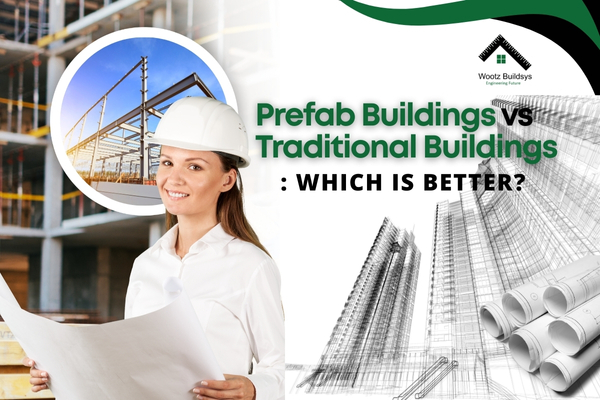
The construction industry has been evolving rapidly, and one of the biggest debates today is whether prefab buildings are better than traditional buildings. With increasing demand for faster, more sustainable, and cost-efficient solutions, prefabricated structures have gained popularity worldwide. But how do they really compare with conventional construction methods?
What Are Prefab Buildings?
Prefab buildings (short for prefabricated buildings) are structures constructed using components manufactured off-site in a controlled factory environment. These components—such as walls, floors, and roofs—are then transported to the construction site for assembly.
The concept is built on efficiency, precision, and speed. Since most of the work is done in factories, on-site labor is reduced, and the risk of weather-related delays is minimized. Prefab buildings can be fully customized and are widely used for residential, commercial, and industrial purposes.
What Are Traditional Buildings?
Traditional buildings refer to conventional construction methods, usually involving on-site assembly of materials like bricks, cement, sand, and concrete. This process relies heavily on manual labor, local resources, and weather conditions.
While traditional construction offers design flexibility and a sense of permanence, it often takes longer to complete and may involve higher costs due to material wastage and extended project timelines.
Key Differences Between Prefab and Traditional Buildings
Let’s break down the major differences between prefab buildings and conventional construction:
1. Speed of Construction
- Prefab Buildings: Significantly faster since components are pre-made in factories. A building can be assembled in weeks.
- Traditional Buildings: Slower due to dependency on labor, weather conditions, and on-site processes. Projects may take months or years.
2. Cost-Effectiveness
- Prefab Buildings: Lower overall cost due to reduced labor, minimal material wastage, and faster project delivery.
- Traditional Buildings: Higher costs from prolonged timelines, labor expenses, and potential rework caused by errors.
3. Quality and Precision
- Prefab Buildings: Manufactured in controlled environments, ensuring high accuracy and consistency.
- Traditional Buildings: Quality may vary depending on labor skill, materials used, and on-site supervision.
4. Design Flexibility
- Prefab Buildings: Customizable but may have limitations depending on module design.
- Traditional Buildings: Highly flexible in terms of architectural design, shapes, and aesthetics.
5. Durability and Strength
- Prefab Buildings: Built with modern materials like steel and insulated panels, offering durability, weather resistance, and energy efficiency.
- Traditional Buildings: Long-lasting and strong, especially RCC (Reinforced Cement Concrete), but may require more maintenance over time.
6. Sustainability
- Prefab Buildings: Eco-friendly due to recyclable materials, reduced waste, and energy-efficient features.
- Traditional Buildings: Generate more construction waste and consume more resources, making them less sustainable.
Benefits of Prefab Buildings
Prefab buildings are becoming increasingly popular because of their unique advantages:
- Faster project completion → Saves time for developers and owners.
- Lower overall costs → Reduces labor and material wastage.
- Sustainable and eco-friendly → Promotes green construction practices.
- High quality → Ensures precision manufacturing.
- Flexibility in applications → Suitable for homes, offices, schools, hospitals, warehouses, and more.
Benefits of Traditional Buildings
While prefab buildings have clear advantages, traditional methods still hold value in certain situations:
- Architectural flexibility → Ideal for complex, artistic, or heritage-inspired designs.
- Perception of permanence → Often seen as stronger and more reliable.
- Established methods → Familiar to local labor and communities.
Which Is Better: Prefab Buildings or Traditional Buildings?
The answer depends on your project requirements:
- If you need faster construction, lower costs, and sustainability, prefab buildings are the better choice.
- If your project demands unique architecture, long-term permanence, or heritage-style designs, traditional buildings may be more suitable.
In most modern scenarios—industrial warehouses, commercial complexes, schools, hospitals, and even homes—prefab buildings are proving to be the smarter and more efficient solution.
Conclusion
The debate of prefab buildings vs traditional buildings doesn’t have a one-size-fits-all answer. However, as cities expand and industries seek quick, reliable, and eco-friendly infrastructure, prefab construction is becoming the go-to option for developers and businesses.
By combining speed, cost savings, and sustainability, prefab buildings represent the future of modern construction—without completely replacing traditional methods that still hold their ground in certain architectural contexts.
If you’re planning a project, carefully weigh the pros and cons of both methods. Chances are, a prefab building might be exactly what you need to balance efficiency, quality, and affordability.
Frequently Asked Questions (FAQs)
1. What is the main difference between prefab and traditional buildings?
Prefab buildings are constructed using factory-made components that are assembled on-site, while traditional buildings are built entirely on-site using raw materials like bricks, cement, and sand.
2. Are prefab buildings cheaper than traditional buildings?
Yes, prefab buildings are generally more cost-effective because they reduce labor requirements, minimize material wastage, and allow for faster project completion.
3. How long does it take to build a prefab building compared to a traditional one?
Prefab buildings can often be completed within weeks, while traditional buildings may take several months or even years, depending on project size and complexity.
4. Are prefab buildings durable and safe?
Yes, modern prefab buildings are built with high-quality materials like steel and insulated panels, making them durable, weather-resistant, and energy-efficient.


